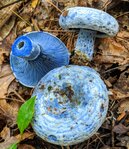

Milky caps are the only group of mushrooms that release liquid when their gills are cut. Liquid can pour out of them in such huge volumes that it can drench your hands like someone turned on a water faucet. A shocking surprise from such small, dry looking, often quite delicious, fungal fruiting bodies.
The liquid they release is referred to as “latex” and is very similar to the latex one finds in plants and is comprised of gum resins, waxes, fats, sugars and tannins. It is theorized that the latex is a defense mechanism to deter insects or snails from eating them; filling their mouths with the sheer volume and viscosity of their latex so as to deter a diner and encourage them to go elsewhere for a meal.
Their latex is typically white colored but it can also be orange, yellow, red and even blue, a color not normally found in nature. Even blueberries are not blue, but rather purple colored. Their latex can also change color as it ages and even stain their tissue, or your hands, various colors. All of this colorful display is useful in identifying them.
Milky Caps used to be grouped together with another similar genus, “Russulas” who are nicknamed “Brittle Caps”, because they all have very brittle flesh and can crumble in your hands. However, since Milky Caps release latex, they were long ago separated into their own genus. Modern DNA analysis has since divided Lactarius into half a dozen similar genera, the second largest of which is called “Lactifluus”.
Some milky caps are poisonous, but only in terms of causing gastric upset. Those can be effectively ruled out for eating based on a few rules of thumb such as if the latex is yellow colored or if the latex or flesh tastes bitter. Don’t worry, it is important to lick and even taste the flesh of many fungi out in the field, without swallowing, to assist in species identification.
All milky caps are “ectomycorrhizal”, meaning they grow in a symbiotic relationship with nearby trees, rather than being “saprobic” or decayers of plant material. They are quite gregarious and are not particularly tree specialists, like many Porcini species are for example, and can develop harmonious relationships with a number of types of hardwoods or conifer species.
There are over 500 species of milky caps and beyond the fact that they release latex, they often have the following characteristics. They may have different colored rings on their caps, referred to as being “zonate”. They lack a ring or partial veil on their stems and often have pits or little craters cut out of their stems, a feature called being “scrobiculate”. Most are small and dull colored, almost boring, and are often ignored by mushroom hunters.
Some of the famous Milky Caps include: Lactarius indigo, with white and blue rings on their caps and a brilliant, though scanty, blue latex; Lactarius rubidus, the “Candy Cap” mushroom which has the same chemical in it that maple syrup does and is extensively used in baking desserts; Lactarius deliciosus, the “Saffron Milk Cap” which is a prized mushroom in Spain where it is called “Rebellones” and found in all the fall marketplaces there roasted with oil and garlic; and then there is the group of three local and delicious Milky Caps, Lactarius hygrophoroides and corrugis, and Lactifluus volemus. These are all similarly brown colored and exude large volumes of white latex. When tossed with salt and olive oil and roasted in the oven you will devour them in minutes.
As always, never eat wild mushrooms until you are shown them by an expert and have learned their lookalikes first.
Gary Gilbert teaches and leads mushroom walks in the area and is a member of the Boston Mycological Club. He is the originator of “Mycocards”, flashcards for learning mushrooms by genus as well as having recipes in the recent Fantastic Fungi Community Cookbook.